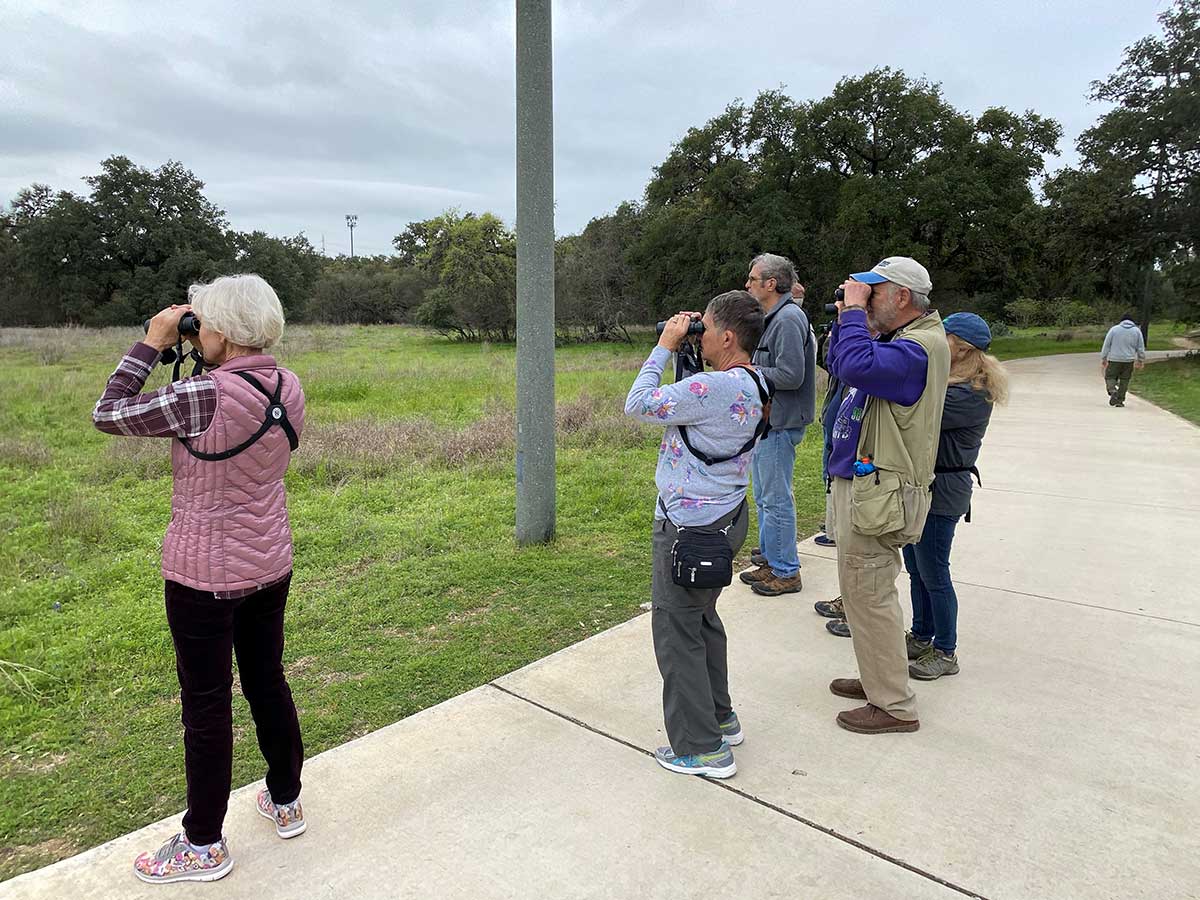This morning brought an opportunity to go birding with the Bexar Audubon Society at Walker Ranch Park.
Upon my arrival at the park, I was surprised to see a group of 13 other birds gathered there for the Audubon Walk. I walked up and introduced myself to everyone. When I was asked if I was from the media (due to the microphone I was carrying), I responded that I am here to capture some bird songs! This made several people’s eyes light up and spurred a few questions about my gear and how long I’ve been recording.
Today’s walk was led by Bexar Audubon Society Committee Member, Lora Reynolds. The BAS leads weekly bird walks all over the city of San Antonio, Texas. Lora is a master auditory birder and was able to point out a majority of the species we observed today just by hearing them.
Our group was a nice mix of birders from novice to expert and with this many eyes to the trees we were sure to see a bunch of species along the park trails.

My first bird of the morning was the ubiquitous Northern Cardinal. This bird’s song was a constant companion throughout the walk.
Not too long after heading down the first trail, Lora started calling out various bird species she was hearing and pointed viewers to their general directions.
The first species that caught my attention was the White-eyed Vireo. Lora and several other birders spotted the WEVI in a tree next to our path. I fired up my microphone and capture a minute of its morning song.
A bit further down the path a Red-shoulder Hawk was discovered sitting on a branch watching us as we discussed birds. The entire group gathered together to observe the hawk while Patsy Inglet described how to begin identifying raptors.
“Look for the striping on the chest and for the smear of orange on its shoulders. This bird has a yellow beak with a darker black tip.” She spoke of the Accipiter family and the longer tails you might notice on these birds compared to those of Red-tailed hawks.
The next interesting bird we saw was the Hutton’s Vireo. This bird looked similar to the White-eyed Vireo but had slightly different markings around its eye, with the lighter color extending slightly away from the its beak instead of towards it like the ‘bespectacled’ White-eyed.
With many new birders in our group, it can be a challenge to describe where to look to see a bird, especially when they are new to binoculars. But Patsy’s husband, Tom, had a trick up his sleeve. Out of nowhere Tom activates a green laser and a bright green dot appears six inches below the Hutton’s Vireo. This made it much easier to spot the bird and helped the newbies practice their binocular skills.
Tip: To spot birds easier with your binoculars, look at the bird with your eyes first, then bring the binoculars up to your face and you should be lined up fairly closely with the bird.
Lora’s birding-by-ear skills came in clutch again when she heard a Field Sparrow calling out. A lifer for me, we gathered next to the tree and waited for the bird to come into view. This drab-looking bird had a white eye-ring, brown crown and a pink bill that matched its feet. “Babyface,” the other birders called it. ????
A few minutes later, Lora said she heard the calls of a titmouse coming from a nearby bush. It sounded awfully loud to be a titmouse to me, so I asked what else it might be. “A Carolina Wren,” she replied.
We ventured to the other side of the bush to discover a large fallen tree and two beautiful Carolina Wrens jumping around collecting nesting materials.
Our group was also treated to a Black-and-White Warbler clinging to the twigs above the walking path. This bird is a true acrobat. Like a Nuthatch, this bird has longer claws and clings upside or any other direction as it moves through the trees. This was my first BAWW in Texas. I haven’t seen one of these birds since 2014 when I was in New York City. Here is a picture I took of that bird on Long Island:

After the bird walk concluded, I connected with a few of the Bexar Audubon officials and learned of a workshop for the iNaturalist app. There is an upcoming City Nature Challenge where cities will compete to see who can make the most observations of nature April 24 – 27.
Reflecting on today’s bird walk, I learned that I need to be better prepared with AA batteries. My Zoom H4N Recorder died halfway through the bird walk. Next time I plan to come with a fresh pair since this recording device loves to eat through batteries!
Capturing audio clips in a group setting continues to be a challenge but one that is beneficial to overcome. The reason being is that I find far less bird species when I bird alone, so the extra ears to the trees is worth the opportunity to capture something I wouldn’t otherwise be able to identify.
I was lucky to have understanding and supportive fellow birders who offered to stay quiet and further back when they knew I was trying to capture a bird song. But I can only do so much regarding cyclists and overhead jets.
I look forward to subsequent bird walks with the Bexar Audubon and for opportunities to get more involved in my local community.


